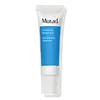What's inside
What's inside
 Key Ingredients
Key Ingredients

 Benefits
Benefits

 Concerns
Concerns

No concerns
 Ingredients Side-by-side
Ingredients Side-by-side

Water
Skin ConditioningHamamelis Virginiana Water
AstringentGlycerin
HumectantPentylene Glycol
Skin ConditioningHydroxyethyl Urea
HumectantHydroxyethyl Acrylate/Sodium Acryloyldimethyl Taurate Copolymer
Emulsion StabilisingDimethicone
EmollientPolymethylsilsesquioxane
Tapioca Starch
Diisopropyl Sebacate
EmollientSalicylic Acid
MaskingUrea
BufferingYeast Amino Acids
HumectantTrehalose
HumectantInositol
HumectantTaurine
BufferingBetaine
HumectantZingiber Officinale Root Extract
MaskingBisabolol
MaskingSodium Hyaluronate
HumectantMelia Azadirachta Leaf Extract
Skin ConditioningMelia Azadirachta Flower Extract
Skin ConditioningCorallina Officinalis Extract
Skin ConditioningCoccinia Indica Fruit Extract
Skin ConditioningSolanum Melongena Fruit Extract
Skin ConditioningAloe Barbadensis Flower Extract
EmollientCurcuma Longa Root Extract
MaskingOcimum Sanctum Leaf Extract
Skin ConditioningOcimum Basilicum Flower/Leaf Extract
TonicLysolecithin
EmulsifyingSclerotium Gum
Emulsion StabilisingPolyisobutene
Polysilicone-11
Polydextrose
HumectantDextrin
AbsorbentEthylhexyl Hydroxystearate
EmollientPullulan
Xanthan Gum
EmulsifyingAmylopectin
Niacinamide
SmoothingSerine
MaskingButylene Glycol
HumectantPEG-7 Trimethylolpropane Coconut Ether
EmulsifyingSorbitan Isostearate
EmulsifyingPolysorbate 60
EmulsifyingGlyceryl Polyacrylate
Algin
MaskingDisodium Phosphate
BufferingSilica
AbrasiveDipropylene Glycol
HumectantPinus Densiflora Leaf Extract
AntimicrobialDecyl Glucoside
CleansingPotassium Phosphate
BufferingLactobacillus Ferment
Skin ConditioningLeuconostoc/Radish Root Ferment Filtrate
AntimicrobialCaprylyl Glycol
EmollientHexylene Glycol
EmulsifyingDisodium EDTA
Hydroxypropyl Cyclodextrin
MaskingCitric Acid
BufferingPhenoxyethanol
PreservativeBenzoic Acid
MaskingLimonene
PerfumingHydroxycitronellal
PerfumingParfum
MaskingWater, Hamamelis Virginiana Water, Glycerin, Pentylene Glycol, Hydroxyethyl Urea, Hydroxyethyl Acrylate/Sodium Acryloyldimethyl Taurate Copolymer, Dimethicone, Polymethylsilsesquioxane, Tapioca Starch, Diisopropyl Sebacate, Salicylic Acid, Urea, Yeast Amino Acids, Trehalose, Inositol, Taurine, Betaine, Zingiber Officinale Root Extract, Bisabolol, Sodium Hyaluronate, Melia Azadirachta Leaf Extract, Melia Azadirachta Flower Extract, Corallina Officinalis Extract, Coccinia Indica Fruit Extract, Solanum Melongena Fruit Extract, Aloe Barbadensis Flower Extract, Curcuma Longa Root Extract, Ocimum Sanctum Leaf Extract, Ocimum Basilicum Flower/Leaf Extract, Lysolecithin, Sclerotium Gum, Polyisobutene, Polysilicone-11, Polydextrose, Dextrin, Ethylhexyl Hydroxystearate, Pullulan, Xanthan Gum, Amylopectin, Niacinamide, Serine, Butylene Glycol, PEG-7 Trimethylolpropane Coconut Ether, Sorbitan Isostearate, Polysorbate 60, Glyceryl Polyacrylate, Algin, Disodium Phosphate, Silica, Dipropylene Glycol, Pinus Densiflora Leaf Extract, Decyl Glucoside, Potassium Phosphate, Lactobacillus Ferment, Leuconostoc/Radish Root Ferment Filtrate, Caprylyl Glycol, Hexylene Glycol, Disodium EDTA, Hydroxypropyl Cyclodextrin, Citric Acid, Phenoxyethanol, Benzoic Acid, Limonene, Hydroxycitronellal, Parfum
Ingredients Explained
These ingredients are found in both products.
Ingredients higher up in an ingredient list are typically present in a larger amount.
Betaine is a common humectant (a substance that promotes retention of moisture). It's known to be gentle on the skin and can help balance hydration.
This ingredient is best for improving hydration and soothing irritated skin. Studies also show it helps even out skin tone.
Fun fact: Betaine is naturally created in the skin and body. The kind found within cosmetic products can be either plant-derived or synthetic.
Another name for betaine is trimethylglycine.
Learn more about BetaineGlycerin is already naturally found in your skin. It helps moisturize and protect your skin.
A study from 2016 found glycerin to be more effective as a humectant than AHAs and hyaluronic acid.
As a humectant, it helps the skin stay hydrated by pulling moisture to your skin. The low molecular weight of glycerin allows it to pull moisture into the deeper layers of your skin.
Hydrated skin improves your skin barrier; Your skin barrier helps protect against irritants and bacteria.
Glycerin has also been found to have antimicrobial and antiviral properties. Due to these properties, glycerin is often used in wound and burn treatments.
In cosmetics, glycerin is usually derived from plants such as soybean or palm. However, it can also be sourced from animals, such as tallow or animal fat.
This ingredient is organic, colorless, odorless, and non-toxic.
Glycerin is the name for this ingredient in American English. British English uses Glycerol/Glycerine.
Learn more about GlycerinPentylene glycol is typically used within a product to thicken it. It also adds a smooth, soft, and moisturizing feel to the product. It is naturally found in plants such as sugar beets.
The hydrophilic trait of Pentylene Glycol makes it a humectant. As a humectant, Pentylene Glycol helps draw moisture from the air to your skin. This can help keep your skin hydrated.
This property also makes Pentylene Glycol a great texture enhancer. It can also help thicken or stabilize a product.
Pentylene Glycol also acts as a mild preservative and helps to keep a product microbe-free.
Some people may experience mild eye and skin irritation from Pentylene Glycol. We always recommend speaking with a professional about using this ingredient in your routine.
Pentylene Glycol has a low molecular weight and is part of the 1,2-glycol family.
Learn more about Pentylene GlycolWater. It's the most common cosmetic ingredient of all. You'll usually see it at the top of ingredient lists, meaning that it makes up the largest part of the product.
So why is it so popular? Water most often acts as a solvent - this means that it helps dissolve other ingredients into the formulation.
You'll also recognize water as that liquid we all need to stay alive. If you see this, drink a glass of water. Stay hydrated!
Learn more about Water